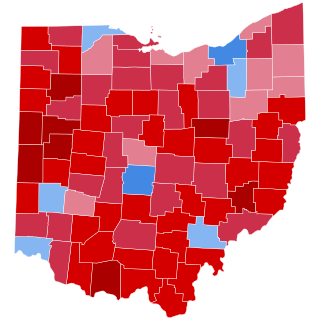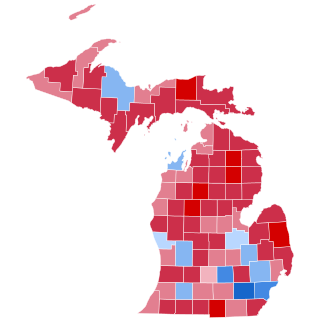
In American politics, a swing state is any state that could reasonably be won by either the Democratic or Republican candidate in a statewide election, most often referring to presidential elections, by a swing in votes. These states are usually targeted by both major-party campaigns, especially in competitive elections. Meanwhile, the states that regularly lean to a single party are known as "safe states", as it is generally assumed that one candidate has a base of support from which a sufficient share of the electorate can be drawn without significant investment or effort by the campaign.

The 2008 Iowa Democratic presidential caucus occurred on January 3, and was the state caucuses of the Iowa Democratic Party. It was the first election for the Democrats of the 2008 presidential election. Also referred to as "the First in the Nation Caucus," it was the first election of the primary season on both the Democratic and Republican sides. Of the eight major Democratic presidential candidates, then-U.S. Senator Barack Obama of Illinois received the most votes and was ultimately declared the winner of the Iowa Democratic Caucus of 2008, making him the first African American to win the caucus and the first African American to win a primary state since Jesse Jackson in 1988. Former U.S. Senator John Edwards of North Carolina came in second place and then-U.S. Senator Hillary Clinton of New York finished third, though Clinton received more delegates than Edwards. Campaigning had begun as early as two years before the event.

The Bradley effect is a theory concerning observed discrepancies between voter opinion polls and election outcomes in some United States government elections where a white candidate and a non-white candidate run against each other. The theory proposes that some white voters who intend to vote for the white candidate would nonetheless tell pollsters that they are undecided or likely to vote for the non-white candidate. It was named after Los Angeles mayor Tom Bradley, an African-American who lost the 1982 California gubernatorial election to California attorney general George Deukmejian, a white person, despite Bradley being ahead in voter polls going into the elections.

The 2008 United States presidential election in Florida took place on November 4, 2008, and was part of the 2008 United States presidential election. Voters chose 27 representatives, or electors to the Electoral College, who voted for president and vice president.

Elections were held on November 2, 2010, to determine Michigan's 15 members of the United States House of Representatives. Representatives were elected for two-year terms to serve in the 112th United States Congress from January 3, 2011, until January 3, 2013. Primary elections were held on August 3, 2010.

Elections were held on November 2, 2010, to determine North Carolina's 13 members of the United States House of Representatives. Representatives were elected for two-year-terms to serve in the 112th United States Congress from January 3, 2011, until January 3, 2013. Primary elections were held on May 4, 2010, and primary runoff elections were held on June 22, 2010.

Elections were held on November 2, 2010, to determine Illinois's 19 members of the United States House of Representatives. Representatives were elected for two-year terms to serve in the 112th United States Congress from January 3, 2011, until January 3, 2013. Primary elections were held on February 2, 2010.

Elections were held on November 2, 2010 to determine Maine's two members of the United States House of Representatives. Representatives were elected for two-year terms to serve in the 112th Congress from January 3, 2011 until January 3, 2013. Primary elections were held on June 8, 2010.

Elections were held on November 2, 2010, to determine Missouri's nine members of the United States House of Representatives. Representatives were elected for two-year terms to serve in the 112th Congress from January 3, 2011, until January 3, 2013. Primary elections were held on August 3, 2010.

Elections were held on November 2, 2010 to determine Utah's three members of the United States House of Representatives. Representatives were elected for two-year terms to serve in the 112th United States Congress from January 3, 2011 until January 3, 2013. Primary elections were held on June 22, 2010.

Elections were held on November 2, 2010, to determine Mississippi's four members of the United States House of Representatives. Representatives were elected for two-year terms to serve in the 112th United States Congress from January 3, 2011, until January 3, 2013. Primary elections were held on June 1, 2010, and primary runoff elections on June 22.
Pink vote are the votes cast by gays and lesbians, and is typically considered a voting bloc. Most prevalent in Britain, the concept has already spread to US, where gays and lesbians are substantially more likely to vote Democratic, and Canada with many other countries like South Africa and Australia starting to acknowledge it. The Pink Vote is now well-established across countries in Western Europe, including Germany with gay and lesbian voters being notably more inclined to vote for social democratic parties over right-wing parties and to be far more supportive of EU integration. In addition, there are socio-political movements and political groups formed by LGBT people who are linked to political parties.

The 2020 United States Senate election in Michigan was held on November 3, 2020, to elect a member of the United States Senate to represent Michigan. It was held concurrently with the 2020 U.S. presidential election, as well as other elections to the United States Senate, elections to the United States House of Representatives and various state and local elections.

The 2020 United States Senate election in North Carolina was held on November 3, 2020, to elect a member of the United States Senate to represent the State of North Carolina, concurrently with the 2020 United States presidential election as well as other elections to the United States Senate in other states and elections to the United States House of Representatives and various state and local elections. North Carolina was one of just five states holding presidential, gubernatorial, and senatorial elections concurrently in 2020. On March 3, 2020, Republican incumbent Thom Tillis and Democratic former state senator Cal Cunningham won their respective primaries.

A special election was held for Mayor of the City and County of San Francisco on June 5, 2018, to fill the remainder of the term of Ed Lee, who had died in office on December 12, 2017. Upon Lee's death, London Breed, President of the San Francisco Board of Supervisors, became Acting Mayor of San Francisco, but a vote of six supervisors replaced Breed with Supervisor Mark Farrell. The mayoral election was held concurrently with the statewide direct primary election. In San Francisco, the election for the eighth district member of the board of supervisors was also on the ballot.

The 2020 United States Senate special election in Arizona was held on November 3, 2020, following the death in office of incumbent Republican U.S. Senator John McCain on August 25, 2018. Governor Doug Ducey was required by Arizona law to appoint a Republican to fill the vacant seat until a special election winner could be sworn in. On September 5, 2018, Ducey appointed former U.S. Senator Jon Kyl to fill McCain's seat. However, Kyl announced he would resign on December 31, 2018.

The 2020 United States presidential election in Ohio was held on Tuesday, November 3, 2020, as part of the 2020 United States presidential election in which all 50 states plus the District of Columbia participated. Ohio voters chose electors to represent them in the Electoral College via a popular vote, pitting the Republican Party's nominee—incumbent President Donald Trump and his running mate, Vice President Mike Pence—against the Democratic Party nominee, former Vice President Joe Biden and his running mate, California Senator Kamala Harris. Ohio had 18 electoral votes in the Electoral College.

The 2020 United States presidential election in Maine was held on Tuesday, November 3, 2020, as part of the 2020 United States presidential election in which all 50 states plus the District of Columbia participated. Maine voters chose electors to represent them in the Electoral College via a popular vote, pitting the Republican Party's nominee, incumbent President Donald Trump, and running mate Vice President Mike Pence against Democratic Party nominee, former Vice President Joe Biden, and his running mate California Senator Kamala Harris. Maine has four electoral votes in the Electoral College. Unlike all other states except Nebraska, Maine awards two electoral votes based on the statewide vote, and one vote for each congressional district.

The 2020 United States presidential election in Michigan was held on Tuesday, November 3, 2020, as part of the 2020 United States presidential election in which all 50 states plus the District of Columbia participated. Michigan voters chose electors to represent them in the Electoral College via a popular vote, pitting the Republican Party's nominee, incumbent President Donald Trump of Florida, and his running mate, Vice President Mike Pence of Indiana against the Democratic Party nominee, former Vice President Joe Biden of Delaware, and his running mate, Senator Kamala Harris of California. Michigan had 16 electoral votes in the Electoral College.

The 2020 United States presidential election in Minnesota was held on Tuesday, November 3, 2020, as part of the 2020 United States presidential election in which all 50 states plus the District of Columbia participated. Minnesota voters chose electors to represent them in the Electoral College via a popular vote, pitting the Republican Party's nominee, incumbent President Donald Trump, and running mate Vice President Mike Pence against the Democratic Party nominee, former Vice President Joe Biden, and his running mate California Senator Kamala Harris. Minnesota has ten electoral votes in the Electoral College.


















